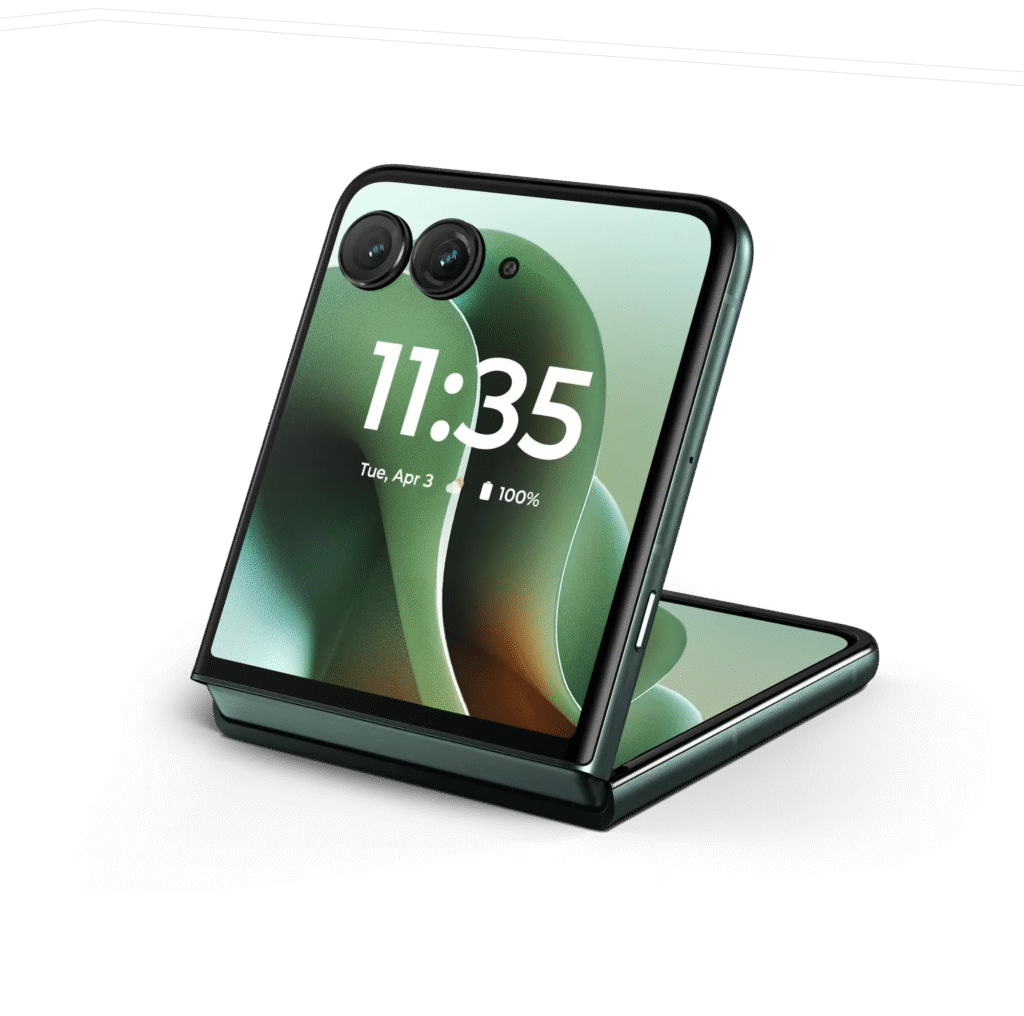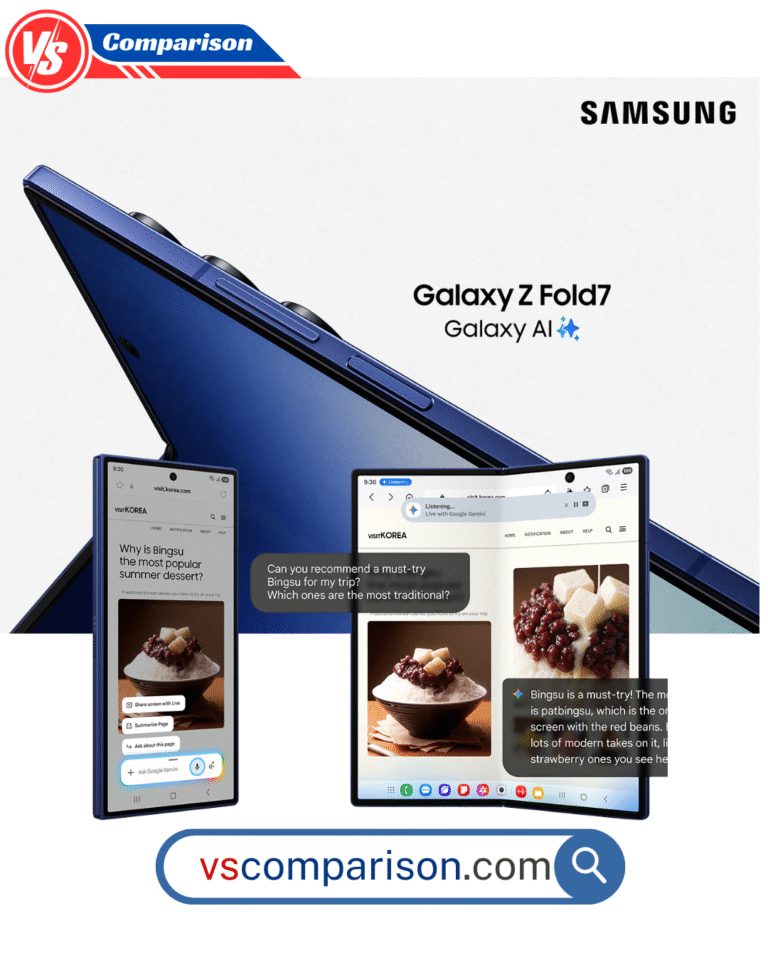
The Motorola Razr 60 Ultra, launched in April 2025, sets a new standard for flip phones with its flagship-grade Snapdragon 8 Elite chipset, expansive 4-inch cover display, and a robust 4,700mAh battery.
As Motorola’s most advanced foldable yet, it builds on the Razr Plus (2024) with significant upgrades, positioning itself as a direct competitor to the Samsung Galaxy Z Flip7.
With vegan leather finishes, 165Hz displays, and full app support on the cover screen, the Razr 60 Ultra aims to redefine the flip phone experience.
In this review, we explore its display, build, camera, battery, performance, pricing, and unique features, comparing it with the Z Flip7 to determine which flip phone leads in 2025. For more Samsung insights, check our review of the Galaxy S25 Ultra.
Display: Immersive and Smooth with Full App Access
The Razr 60 Ultra’s displays are a highlight, featuring a 7-inch pOLED internal display and a 4-inch pOLED cover screen, both with a 165Hz refresh rate, surpassing the Z Flip7’s 120Hz displays.
The internal screen delivers a 2640x1080px resolution (Super HD+), slightly sharper than the Z Flip7’s 6.9-inch AMOLED (1080x2520px).
The cover screen, with a 1272x1080px resolution, supports full app usage out of the box, unlike the Z Flip7’s 4.1-inch cover display, which requires Good Lock for similar functionality.
Motorola’s claimed 4,500-nit peak brightness is optimistic, but it competes well with the Z Flip7’s 2,600 nits. Compared to the Razr Plus (2024), the Ultra’s cover screen is larger (4.0″ vs. 3.6″) and smoother (165Hz vs. 120Hz).
| Feature | Specification |
|---|---|
| Main Display | 7.0-inch pOLED, 165Hz, HDR10+, 4500 nits (peak, claimed), 2640x1080px, 413ppi |
| Cover Display | 4.0-inch pOLED, 165Hz, 4500 nits (peak, claimed), 1272x1080px |
| Improvements from Razr Plus (2024) | Cover: 3.6″ to 4.0″, 120Hz to 165Hz; Main: same size, sharper resolution |
| Comparison with Z Flip7 | Larger internal display (7.0″ vs. 6.9″), higher refresh rate (165Hz vs. 120Hz), full app support on cover screen |
Key Highlights:
- 165Hz refresh rate for ultra-smooth scrolling on both screens.
- Full app access on cover display, surpassing Z Flip7’s widget-focused approach.
- Slightly sharper internal display than Z Flip7, though crease visibility is similar.
Dimensions and Build Material: Premium and Durable
At 188g and 7.2mm unfolded (15.1mm folded), the Razr 60 Ultra is slightly heavier and thicker than the Z Flip7 (188g, 6.5mm unfolded).
Its titanium-reinforced hinge and Gorilla Glass Ceramic back provide excellent scratch resistance, while vegan leather finishes (Midnight Blue, Hot Pink, Mocha Mousse) offer a premium, tactile feel compared to the Z Flip7’s glass-and-aluminum build.
Both phones have an IP48 rating, protecting against water but not fine dust, unlike the Galaxy S25 Ultra’s IP68. The Razr’s hinge is robust but less flexible than the Z Flip7’s, which supports steeper angles.
Compared to the Razr Plus (2024), the Ultra is slimmer with a stronger hinge.
| Feature | Specification |
|---|---|
| Dimensions | 170.8 x 74.0 x 7.2mm (unfolded), 88.0 x 74.0 x 15.1mm (folded) |
| Weight | 199g |
| Materials | Gorilla Glass Ceramic (back), vegan leather options, titanium hinge |
| Build | IP48 dust/water resistant, titanium-reinforced hinge |
| Improvements from Razr Plus (2024) | Thinner (7.4mm to 7.2mm unfolded), titanium hinge |
| Comparison with Z Flip7 | Heavier and thicker, premium vegan leather vs. Z Flip7’s glass |
Key Highlights:
- Vegan leather adds a unique, stylish touch, unlike Z Flip7’s glass finish.
- Titanium hinge enhances durability but is less versatile than Z Flip7’s.
Release Date
The Motorola Razr 60 Ultra was announced on April 8, 2025, with pre-orders starting April 15 and general sales on May 15, 2025.
This early launch gave Motorola a head start over the Z Flip7’s July 25 release, capturing the flip phone market ahead of Samsung’s Galaxy Unpacked event.
Camera Setup: Versatile but No Zoom Lens
The Razr 60 Ultra features a triple 50MP camera system (wide, ultrawide, selfie), an upgrade over the Z Flip7’s 50MP wide, 12MP ultrawide, and 10MP selfie setup.
The 50MP main sensor (f/1.7, OIS) produces sharp, vibrant images, closely matching the Z Flip7’s 50MP camera, though Samsung’s ProVisual Engine excels in low-light conditions.
The 50MP ultrawide (f/2.0, 120° FoV) doubles as a macro lens, and the 50MP selfie camera outperforms the Z Flip7’s 10MP unit for vlogging.
Like the Z Flip7, it lacks a telephoto lens, trailing the Galaxy S25 Ultra’s 5x zoom. Compared to the Razr Plus (2024), the Ultra upgrades the selfie camera from 32MP to 50MP.
| Feature | Specification |
|---|---|
| Main Camera | 50MP, f/1.7, 85° FoV, PDAF, OIS |
| Ultrawide Camera | 50MP, f/2.0, 120° FoV, macro mode |
| Selfie Camera | 50MP, f/2.0, 85° FoV |
| Improvements from Razr Plus (2024) | 50MP selfie camera vs. 32MP, improved AI processing |
| Comparison with Z Flip7 | Higher-res ultrawide and selfie cameras, no telephoto lens |
Key Highlights:
- 50MP across all cameras for consistent quality.
- Superior selfie camera compared to Z Flip7’s 10MP.
- Lacks Z Flip7’s advanced low-light software enhancements.
Video Shooting Modes: Creator-Friendly Features
The Razr 60 Ultra supports 8K@30fps and 4K@60fps video on its rear cameras, with 4K@60fps for the selfie camera, aligning with the Z Flip7’s video capabilities.
Moto AI features like “Catch Me Up” (notification summaries) and “Pay Attention” (voice-to-text) enhance video editing, but Samsung’s Galaxy AI (e.g., Audio Eraser) is more refined.
The Razr’s cover screen serves as a full viewfinder, offering more flexibility than the Z Flip7’s widget-based approach. Compared to the Razr Plus (2024), the Ultra adds 10-bit HDR video support.
| Feature | Specification |
|---|---|
| Rear Camera Video | 8K@30fps, 4K@60fps, 1080p@60/120/240fps, 10-bit HDR |
| Front Camera Video | 4K@60fps, 1080p@60fps, gyro-EIS |
| Improvements from Razr Plus (2024) | 10-bit HDR, enhanced Moto AI editing |
| Comparison with Z Flip7 | Similar video specs, less polished AI editing tools |
Key Highlights:
- Full app support on cover screen enhances vlogging.
- Moto AI is functional but less advanced than Galaxy AI.
Battery: A Standout Advantage
The Razr 60 Ultra’s 4,700mAh battery delivers 9-10 hours of screen time, outlasting the Z Flip7’s 4,300mAh battery (7 hours).

Its 68W wired charging (50% in 15 minutes) and 30W wireless charging surpass the Z Flip7’s 25W wired and 15W wireless. Reverse wireless charging is slightly better at 5W vs. 4.5W.
Compared to the Razr Plus (2024)’s 4,000mAh battery, the Ultra’s capacity and charging speeds are a major leap, making it a leader in flip phone battery performance.
| Feature | Specification |
|---|---|
| Battery Capacity | 4,700mAh |
| Charging | 68W wired (50% in 15 min), 30W wireless, 5W reverse wireless |
| Battery Life | ~33 hours video playback, ~9-10 hours mixed use |
| Improvements from Razr Plus (2024) | 4,000mAh to 4,700mAh, 45W to 68W wired charging |
| Comparison with Z Flip7 | Larger battery, faster charging (68W vs. 25W) |
Key Highlights:
- Best-in-class battery life and charging speeds for flip phones.
- Significantly outperforms Z Flip7 in longevity and recharge time.
Processor and Software: Flagship Power, Shorter Updates
The Razr 60 Ultra’s Qualcomm Snapdragon 8 Elite (3nm) chipset offers top-tier performance, slightly outperforming the Z Flip7’s Exynos 2500 in benchmarks (Geekbench 6: 3,024 single-core vs. 2,267), though the Exynos runs cooler.
Running Android 15 with Hello UI, it provides a near-stock experience with Moto AI features, but only three years of OS updates compared to the Z Flip7’s seven. Compared to the Razr Plus (2024)’s Snapdragon 8s Gen 3, the Ultra’s chipset is a significant upgrade.
| Feature | Specification |
|---|---|
| Chipset | Qualcomm Snapdragon 8 Elite (3nm), Octa-core (1×4.32GHz Cortex-X4, 5×3.53GHz Cortex-A720, 2×2.27GHz Cortex-A520) |
| GPU | Adreno 830 |
| OS | Android 15, Hello UI, 3 years OS updates, 4 years security updates |
| Improvements from Razr Plus (2024) | Snapdragon 8 Elite vs. 8s Gen 3, Android 15 vs. 14 |
| Comparison with Z Flip7 | Stronger benchmark performance, shorter software support |
Key Highlights:
- Snapdragon 8 Elite outperforms Z Flip7’s Exynos in raw power.
- Limited to three OS updates vs. Z Flip7’s seven.
- Z flip7 Comes with Android 16 and One UI 8
Storage Options and Price: Premium Pricing
Starting at $1,299 for 512GB (12GB/16GB RAM), the Razr 60 Ultra is pricier than the Z Flip7 ($1,099 for 256GB, $1,219 for 512GB).
A 1TB/16GB variant costs $1,499, an option unavailable on the Z Flip7. Trade-in deals offer up to $700 off, but the Z Flip7’s lower base price and $1,000 trade-in make it more affordable.
Compared to the Razr Plus (2024), the Ultra doubles base storage (256GB to 512GB).
| Feature | Specification |
|---|---|
| Storage Options | 512GB (12GB/16GB RAM), 1TB (16GB RAM), UFS 4.0 |
| Price | $1,299 (512GB), $1,499 (1TB) |
| Deals | Up to $700 trade-in value |
| Improvements from Razr Plus (2024) | 256GB to 512GB base storage |
| Comparison with Z Flip7 | Higher base price, more storage options |
Other Features: Moto AI and Cover Screen Versatility
- Moto AI: Features like Catch Me Up (notification summaries) and Pay Attention (voice-to-text) boost productivity, but they’re less polished than the Z Flip7’s Galaxy AI (e.g., Audio Eraser, live translation).
- Cover Screen: Full app support makes it more versatile than the Z Flip7’s widget-based Flex Window.
- Fingerprint Sensor: Side-mounted, reliable, similar to Z Flip7.
- Other: 5G, Wi-Fi 7, Bluetooth 5.4, NFC, and a new AI Key for quick feature access. IP48 rating matches Z Flip7. No DeX support, unlike Z Flip7.
Key Upgrades from Razr Plus (2024):
- Larger, smoother cover display with full app support.
- Moto AI enhancements for productivity.
- Titanium hinge for added durability.
Motorola Razr 60 Ultra vs Galaxy Z Flip7
The Razr 60 Ultra excels with a larger 4,700mAh battery (vs. 4,300mAh), faster 68W charging (vs. 25W), and a more versatile cover screen with full app support. Its 50MP cameras across the board outshine the Z Flip7’s 12MP ultrawide and 10MP selfie, though Samsung’s software processing is superior in low light.
The Razr’s Snapdragon 8 Elite edges out the Z Flip7’s Exynos 2500 in performance, but Samsung’s seven-year update commitment and DeX support offer better long-term value.
The Z Flip7’s $1,099 price and 21:9 aspect ratio are more practical than the Razr’s $1,299 price and 22:9 ratio.
The Z Flip7’s hinge is sturdier, but the Razr’s vegan leather design stands out.
Verdict: Razr 60 Ultra vs. Z Flip7
The Motorola Razr 60 Ultra is a premium flip phone with superior battery life, faster charging, and a more functional cover screen than the Galaxy Z Flip7.
Its 165Hz displays and 50MP cameras make it ideal for creators, but the $1,299 price and three-year update promise fall short of the Z Flip7’s $1,099 price and seven-year support.
Compared to the Razr Plus (2024), the Ultra’s chipset, battery, and cover screen are significant upgrades. For users prioritizing battery life and cover screen versatility, the Razr 60 Ultra is the top choice.
However, the Z Flip7’s polished software, DeX support, and lower price make it a better value for most buyers in 2025.


